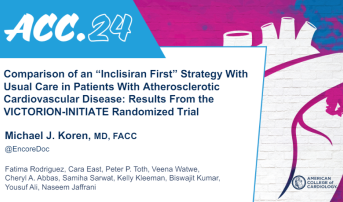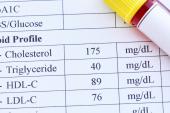Compared With Usual Care, Incorporating Inclisiran Early Cuts LDL
The message from the VICTORION-INITIATE trial is that clinicians need to be more aggressive, said Michael Koren.

ATLANTA, GA—Using inclisiran (Leqvio; Novartis) as soon as possible in the care of patients with atherosclerotic cardiovascular disease (ASCVD) is associated with sustained lowering of LDL cholesterol through 1 year compared with usual care, according to results from the VICTORION-INITIATE clinical trial.
The data “demonstrate the clinical value of initiating inclisiran earlier in the treatment pathway and highlight the urgent need to improve usual care for US patients with ASCVD,” said Michael J. Koren, MD (Jacksonville Center for Clinical Research, FL), who presented the findings here at the American College of Cardiology (ACC) 2024 Scientific Session.
Studies have shown the substantial ability of the small-interfering RNA therapy to lower LDL-cholesterol levels, notably after only twice-yearly injections. However, issues with cost and access have proven to be hurdles for the novel drug, which was approved for use in the US for patients with ASCVD or familial hypercholesterolemia in 2021.
The main message from VICTORION-INITIATE “is we need to do a better job as clinical cardiologists in explaining to people the urgency,” Koren said. “There’s a lot of work to be done. Clinical inertia is a tough thing.”
However, Kaiser noted, access to inclisiran is a big problem. He tasked the manufacturer with trying to “negotiate a better way for providing access to care.
Clinical inertia is a tough thing. Michael J. Koren
Akl Fahed, MD, MPH (Massachusetts General Hospital, Boston, MA), who was not involved in the study, told TCTMD that the financial challenge is not new. “Like all new drugs in cardiology, cost is an issue,” he said in an email. “If the patient can’t afford it [or] payer doesn’t cover it, then you are trying to do your best as a physician with what you have. We had the same discussion around monoclonal antibody PCSK9 inhibitors several years ago.”
Still, with drugs like inclisiran available for many, Fahed said he would like to see it used more often in routine clinical practice. “As an interventional cardiologist, I unfortunately see many of these patients who keep coming back for more procedures after an initial revascularization due to failure of adequate LDL lowering,” he said. “Medication titration is easier said than done, and in a real-world setting, we do a poor job. With a twice-yearly injection, inclisiran provides an opportunity to guarantee the LDL lowering.”
Drastic LDL Lowering
For the study, which was simultaneously published in the Journal of the American College of Cardiology, Koren and colleagues randomized 450 patients with ASCVD (30.9% female; median age 67 years; 12.4% Black; 15.3% Hispanic) who were taking maximally tolerated statins to usual care with or without with inclisiran (284-mg injections at days 0, 90, and 270). Patients were treated at 45 sites across 20 states in the US, and 4.3% of the usual-care arm ended up receiving inclisiran.
Mean baseline LDL cholesterol was 97.4 mg/dL and 97.1% of patients had health insurance. Notably, while only one-quarter of patients overall reported statin intolerance, 90% took statins at baseline, but only five patients (1.1%) were taking ezetimibe.
Patients treated initially with inclisiran saw greater drops in LDL-cholesterol levels than those treated with usual care on day 330 (60% vs 7%; P < 0.001). Statin discontinuation rates were comparable between the groups (6% vs 16.7%), which fell within the 15% margin set for noninferiority.
With a twice-yearly injection, inclisiran provides an opportunity to guarantee the LDL lowering. Akl Fahed
More than two-thirds of the inclisiran arm (69.8%) achieved a greater than 50% drop in LDL cholesterol by day 330 compared with only 5.3% of those assigned to usual care (P < 0.001). Moreover, a greater proportion of patients randomized to the inclisiran-first arm compared with usual care achieved LDL-cholesterol levels of less than 70 mg/dL (81.8% vs 22.2%) as well as less than 55 mg/dL (71.6% vs 8.9%; P < 0.001 for both). The inclisiran-first strategy was also associated with significant drops in total cholesterol, non-HDL cholesterol, very-low-density lipoprotein cholesterol, triglycerides, apoB, and Lp(a), as well as with an increase in HDL cholesterol.
While rates of treatment-emergent adverse events (TEAEs; 62.8% vs 53.7%)—including COVID-19—and serious TEAEs (11.5% vs 13.4%) were similar between the inclisiran and usual-care populations, those related to the injection site, including events that led to treatment withdrawal, were more common after inclisiran treatment.
During the session, Koren highlighted that what happened to patients in the usual-care arm “is not necessarily best practice, but it’s actually what’s happening.”
He recalled three patients in clinic over the last week asking if they absolutely need to start a new drug, citing excuses for recent poor diet choices and asking to work harder on getting their lifestyle in check. “We want to be nice to patients, but we also know that those things tend to not work,” Koren said. “We’re helping our patients and being kind to our patients when we tell them, ‘Well, maybe you should take an extra medicine and also work on your diet.’”
Ezetimibe and Socioeconomics
Fahed said the LDL-lowering results the trial achieved with inclisiran were “great to see, but not surprising.” But the low statin discontinuation rates in this cohort were unexpected, he added. “I was also surprised by how poorly the control group did with only 7% reduction in LDL levels. I wonder if part of this is related to poor access to other drugs like ezetimibe in the study population which included a large proportion of participants from lower economic status and underrepresented minorities.”
Kaiser, too, was struck by the low rate of ezetimibe use in VICTORION-INITIATE. “Such underuse of such a cheap drug,” he said, noting that ezetimibe was available as a generic during the study period.
The results are obviously good with inclisiran, but the frustration related to access means that these benefits cannot yet be attained by the greater population, Kaiser lamented. “We know that cardiovascular disease affects a lot of people who are in developing countries and . . . they have limited economic access to healthcare,” he said.
As the community waits to see cardiovascular outcomes and long-term safety data expected with ORION-4, Fahed said he would also like to see “more cost-effectiveness data [that] will help incentivize payers.”
Kaiser agreed. “When we have data from outcomes studies with inclisiran, this may drive the FDA to recommend it as a good strategy to reduce cardiovascular outcomes. Then maybe there will be more coverage by insurance companies.”
Yael L. Maxwell is Senior Medical Journalist for TCTMD and Section Editor of TCTMD's Fellows Forum. She served as the inaugural…
Read Full BioSources
Koren MJ, Rodriguez F, East C, et al. An inclisiran first strategy vs usual care in patients with atherosclerosis. J Am Coll Cardiol. 2024;Epub ahead of print.
Disclosures
- The study was funded by Novartis.
- Michael J. Koren is an employee of a company that received PI fees for his participation in the trial and that has received study grants and consulting fees from multiple manufacturers of PCSK9 inhibitors and other treatments for lipid disorders. He is a Past-President of the Academy of Physicians in Clinical Research.
- Kaiser reports serving as a speaker for Novartis.
- Fahed reports no relevant conflicts of interest.






Comments